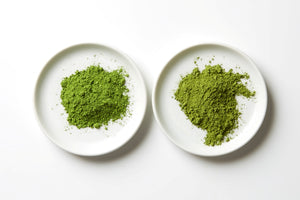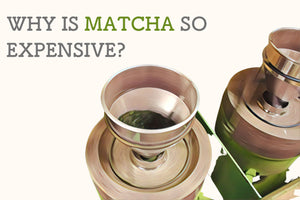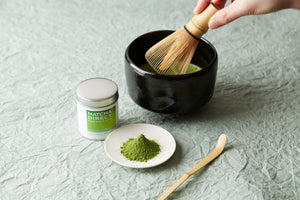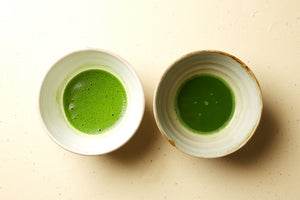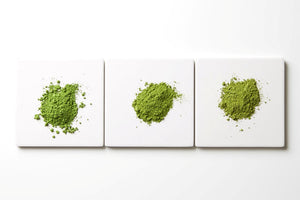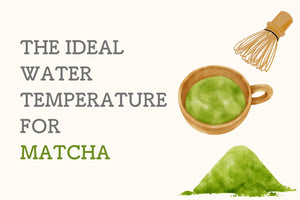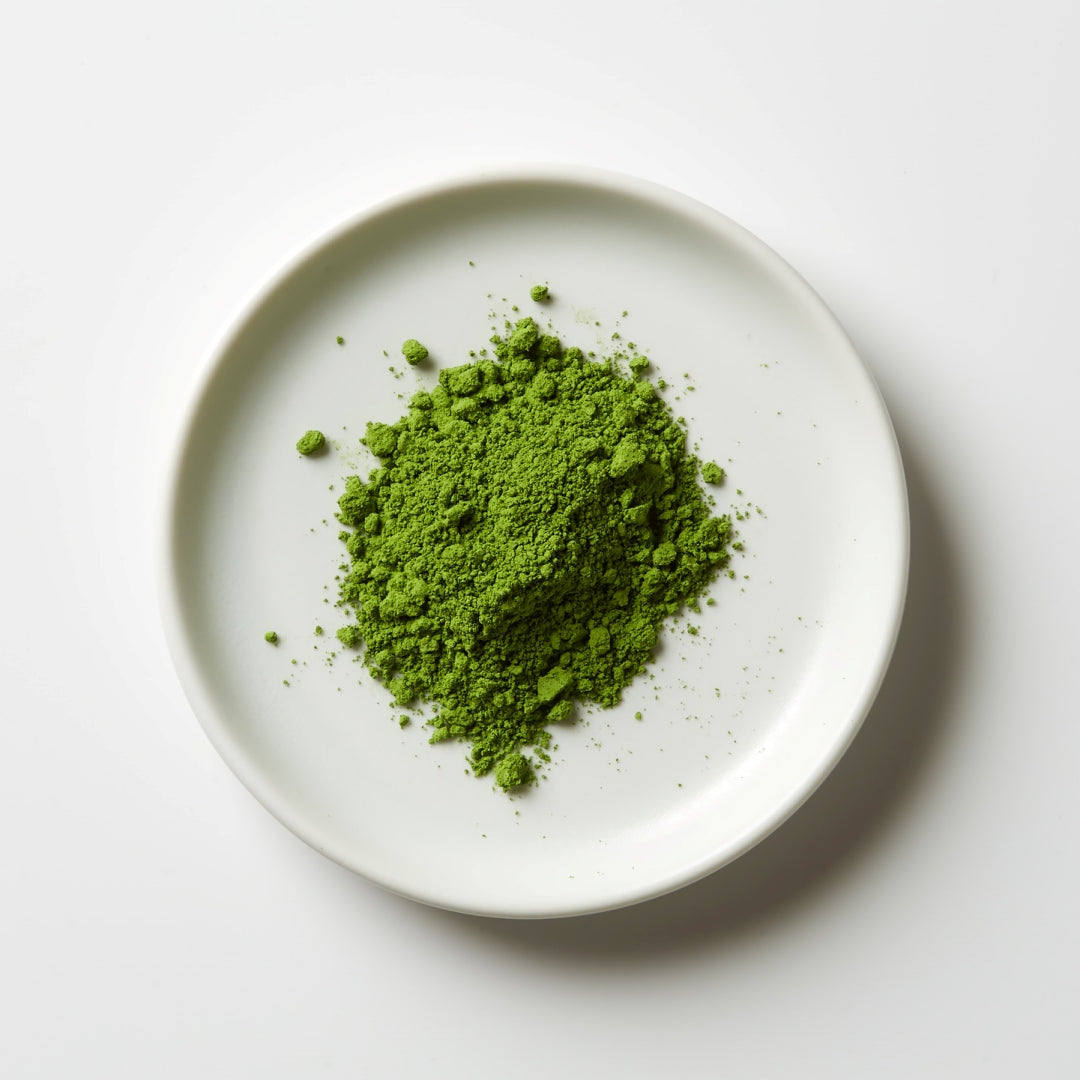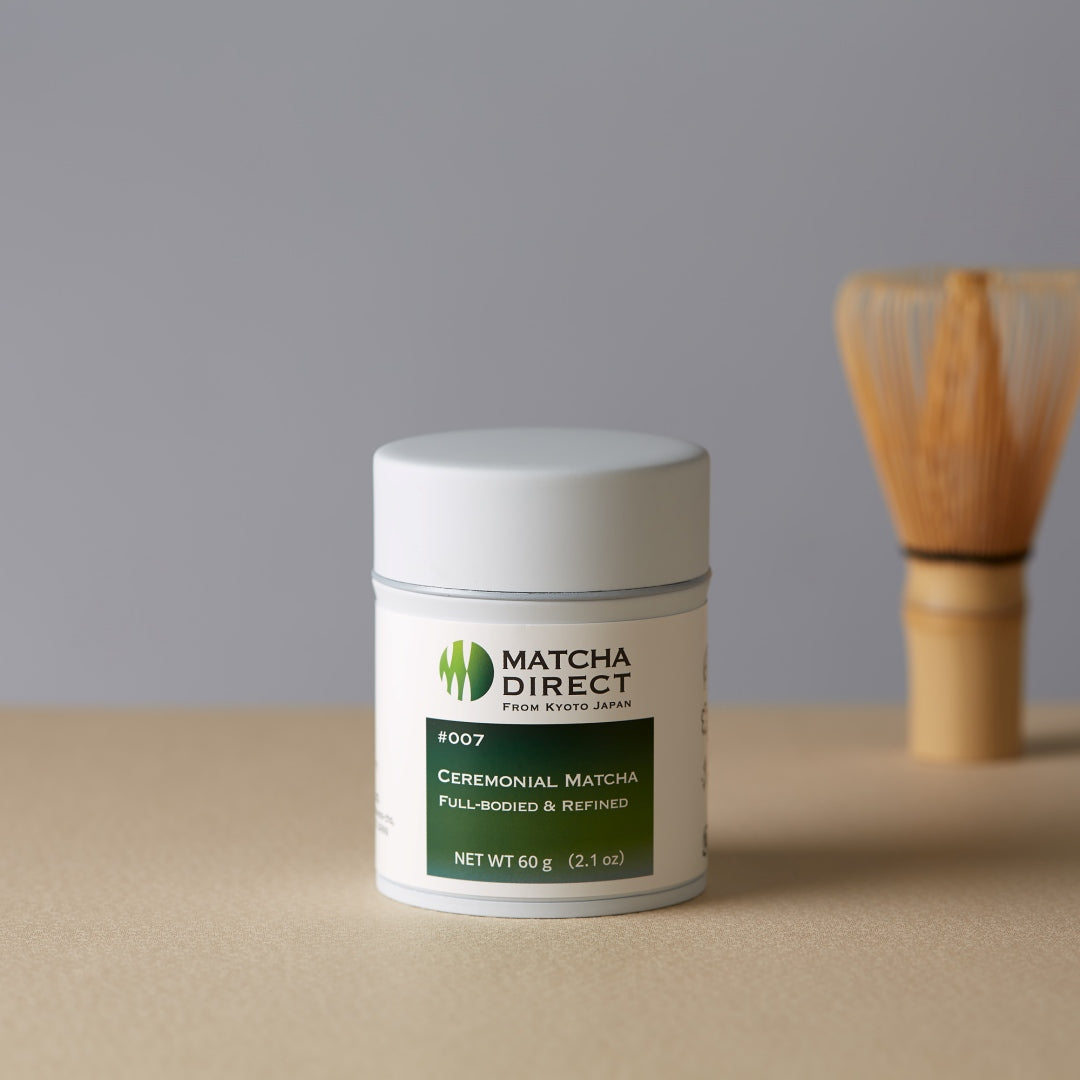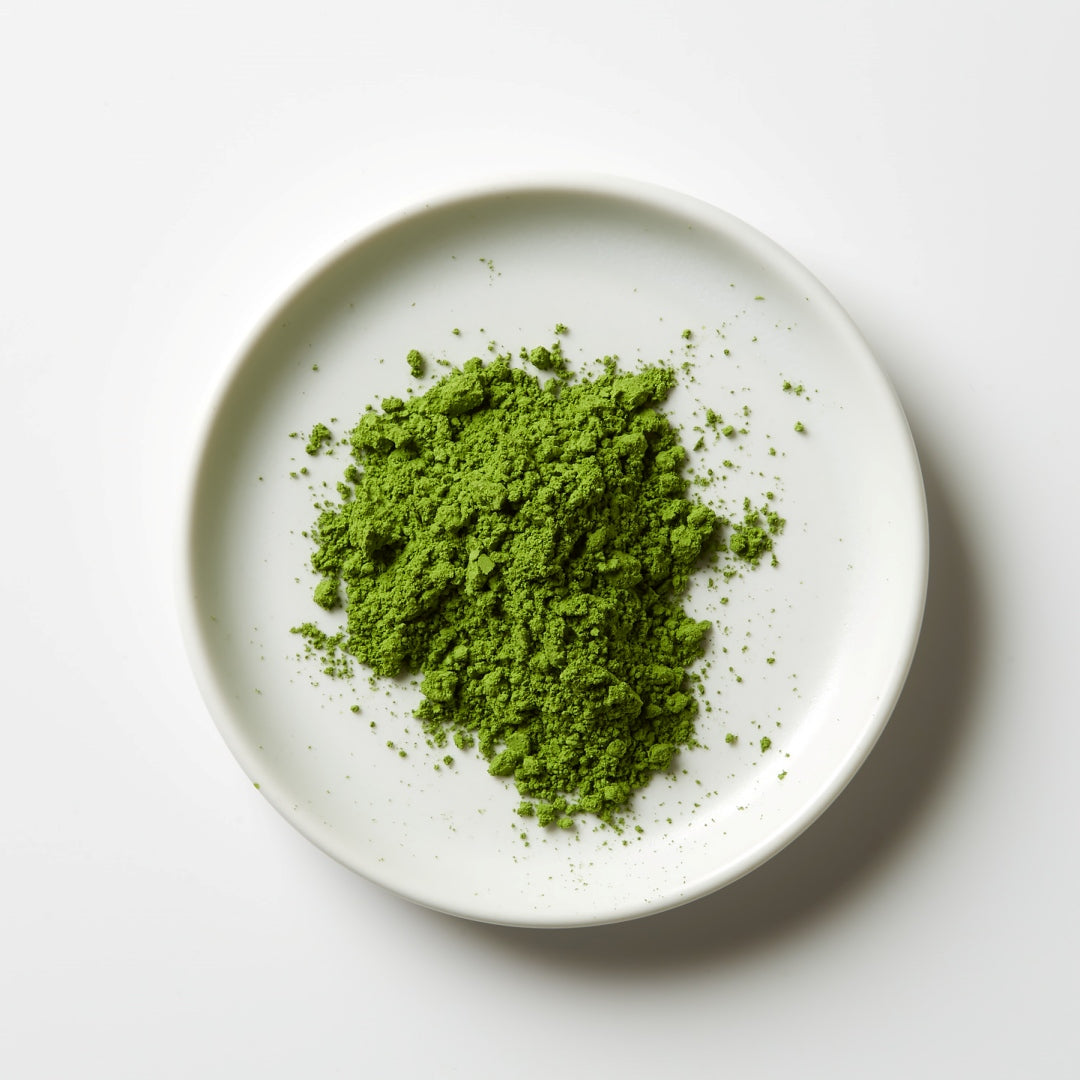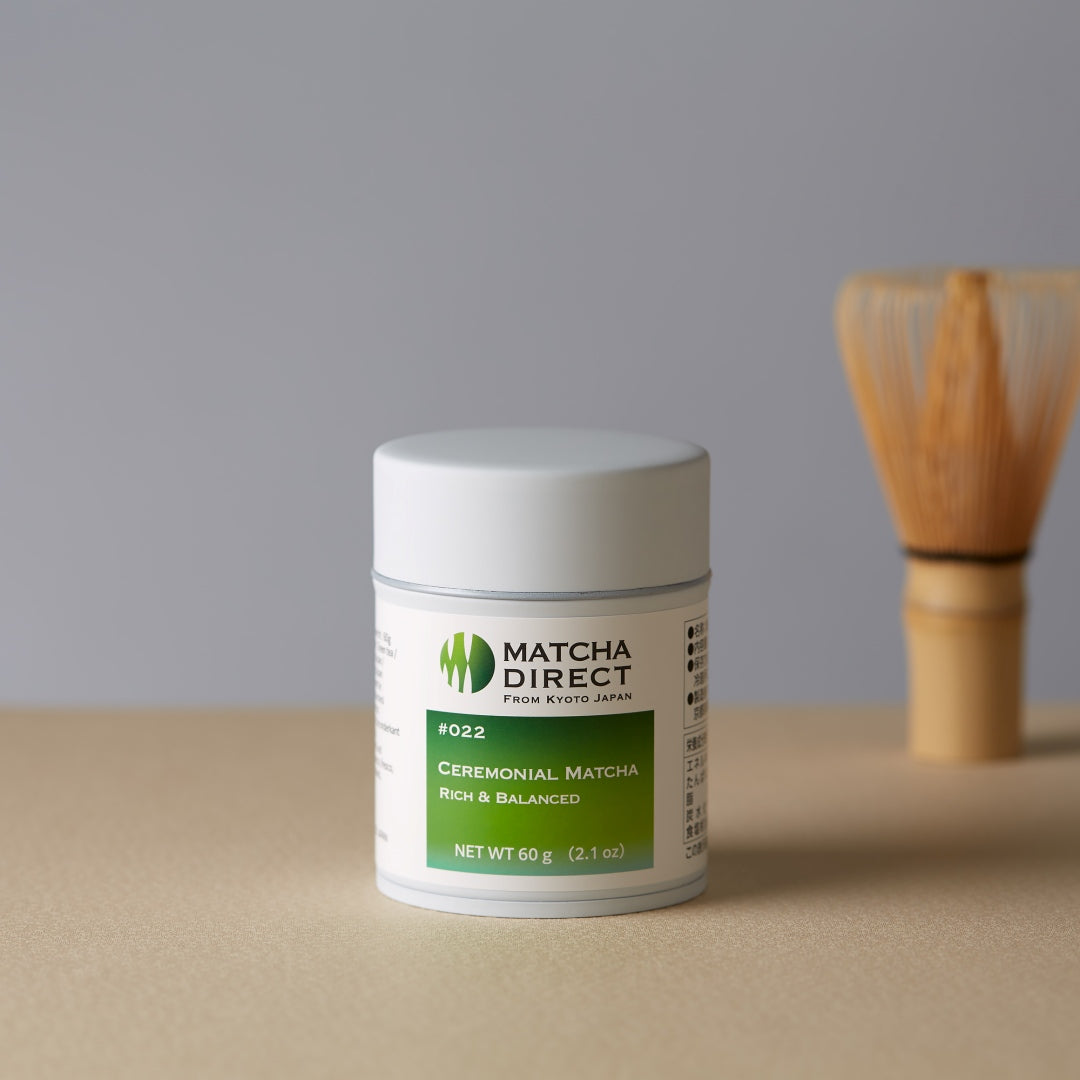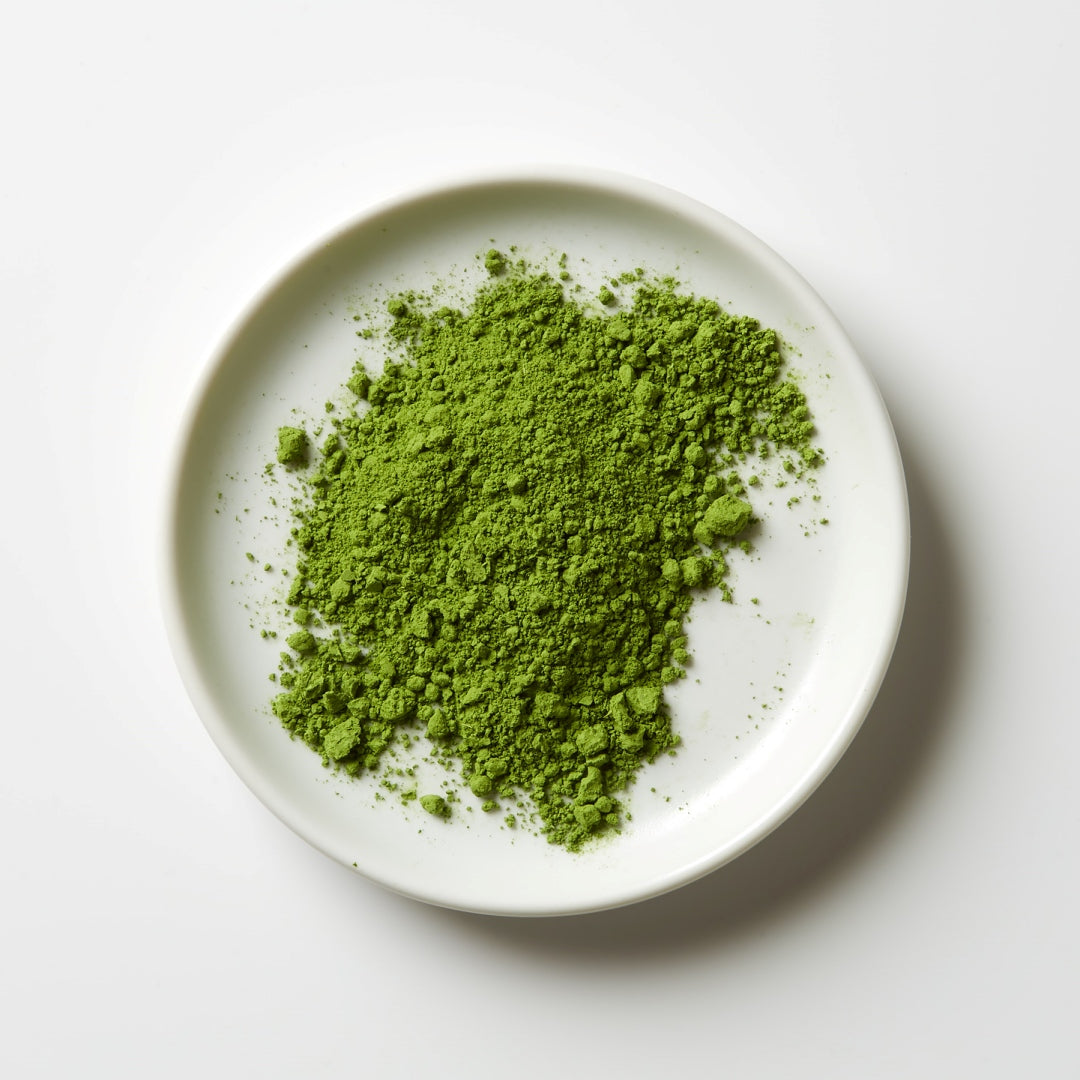What is Ceremonial Matcha? - Differences from Culinary Matcha

What is Ceremonial Matcha?
Let me get straight to the point, ceremonial matcha refers to high-quality matcha that embodies the true color, aroma, and flavor of matcha as used in Japanese tea ceremonies. Hence, it is the optimal choice for drinking.
Especially when drinking matcha dissolved directly in water or hot water, without combining it with other ingredients like milk, the quality of the matcha can be directly perceived. Therefore, choosing ceremonial matcha would be more desirable.
Ceremonial Grade Matcha is crafted from the year’s earliest tea sprouts, known as "first flush" leaves. These leaves, often called "shincha" (new tea), are regarded as the most premium and finest leaves of the year.
In Japanese tea ceremonies, high-grade matcha is usually made from first flush leaves. Although the term "ceremonial" isn’t strictly defined, "first flush" unmistakably refers to the initial tea harvest of the year, guaranteeing superior quality.
https://matchadirect.kyoto/products/ceremonial-grade-matcha
https://matchadirect.kyoto/products/022-ceremonial-matcha-rich-balanced-60g
Ceremonial Matcha is a Seller-Specific Classification
Ceremonial matcha are clearly designated by their names to suggest their intended uses, and there's no fixed standard for these classifications.
In essence, the term "ceremonial" does not guarantee quality.
However, in Japan, matcha sellers provide matcha suitable for tea ceremonies, considering the credibility of their own brands. Also, the consumers can generally imagine the quality of matcha based on its price range, creating a sort of structure.
On the other hand, regarding ceremonial matcha circulated outside Japan, the complex cross-border trade and varied pricing make it hard to gauge quality. Moreover, various sellers, according to their intentions, may label their product as "ceremonial matcha," resulting in a mixed bag of goods. Unfortunately, you won't know the actual quality until you purchase and open it.
To avoid this risk, you could consider looking for ceremonial matcha that mentions "first flush" or "first harvest".
Characteristics of Ceremonial Matcha
While it is important to note that "ceremonial" does not always mean high quality, for the sake of explanation, we will proceed assuming that ceremonial matcha refers to the high-quality matcha used in Japanese tea ceremonies. We'll explain how it differs from other matcha in terms of:
- Color, aroma, and flavor
- Mouthfeel and frothiness
- Freshness
Color, Aroma, Flavor
Tea ceremonies represent the traditional Japanese way of enjoying tea, feeling the beauty of the moment and achieving a sense of tranquility through the act of drinking tea.
Let's take a closer look at this process.
First, the vibrant green color of prepared matcha captures the viewer's heart. This greenness becomes more intense with the increased concentration of chlorophyll, a component of photosynthesis.
Next, the unique fresh, deep aroma of matcha, perceptible as you bring the teacup close to your mouth, provides a unique ambiance. This aroma is specific to ceremonial matcha, known as "shade aroma," primarily influenced by a fragrant component called dimethyl sulfide. This fragrance is more pronounced in high-quality matcha.
Finally, you take a sip of the matcha. The rich yet refreshing taste of the matcha permeates your body, leaving a pleasant sensation that lingers. In terms of flavor, ceremonial matcha is usually chosen for its high levels of umami compounds (primarily an amino acid called L-theanine) and low levels of bitter and astringent components (mainly catechins like EGCg). This balance allows you to vividly experience the umami as soon as you drink the matcha, leading to a pleasurable experience that lasts even after the matcha is consumed.
I have described elements that enhance:
- Color
- Aroma
- Flavor
All these characteristics can be attained specifically because of the use of first flush tea.
First flush tea inherently contains more nutrients accumulated during the winter. By adopting a cultivation method known as 'shaded cultivation', tea leaves are further enhanced the unique characteristics inherent to first-flush tea.
In this method of cultivation, where sunlight is blocked, the tea plant increases its chlorophyll content in an effort to carry out photosynthesis more efficiently. Also, a unique aromatic component called "shade aroma" is produced due to this shading.
As for the flavor compounds, the suppression of photosynthesis prevents the conversion of catechins into L-theanine, creating an ideal situation where there's more umami and less astringency in terms of flavor balance.
As I mentioned earlier, rather than being 'ceremonial', the fact that it is a first flush tea guarantees high quality. Thus, the ones labeled as first flush tea are the ones you can trust without a doubt.
Thus, the color, aroma, and flavor of matcha, the three elements, can be scientifically characterized by specific components.
The more of these components ceremonial matcha has, the higher its value becomes, and the higher its price.
| Element | Component Name |
|---|---|
| Color | Chlorophyll |
| Aroma | Dimethyl Sulfide |
| Flavor | L-Theanine |
Mouthfeel and Frothiness
The second difference between ceremonial matcha and other matcha is related to texture, such as mouthfeel and frothiness.
This depends on the method of grinding the matcha.
There are two methods for grinding matcha, one involves mechanical grinding using ball mills, bead mills, and jet mills, while the other involves traditional stone grinding.
Stone grinding can only grind about 40g per hour per unit, and while most of the industrial grinding has been replaced with machine grinding, stone grinding is still preferred for tea ceremony use.
This preference is due to the excellent mouthfeel and frothiness.
When ground with a stone mill, the tea leaves can be ground more finely than with a machine.
Generally speaking, with stone grinding, the size of the matcha particles can be ground down to less than an average of 10μm (1/100 of 1mm), a fineness that cannot be achieved with machine grinding.
This fineness contributes to the good mouthfeel.
The smaller the particles, the smoother the sensation when they touch the tongue, and the longer the flavor of the matcha lingers on the taste buds.
Also, the frothiness when whisked with a tea whisk varies with the size of the particles, so if you're seeking a fine, creamy frothiness, stone-ground matcha is recommended.
Machine grinding is suited for mass production, so the higher the quality of the tea leaves, the less suitable they are for machine grinding.
Therefore, stone grinding can be a reference for the grinding of scarce high-quality matcha, which is less available in the market.
Freshness
In the Japanese tea ceremony, fresh matcha is preferred, with people often not keeping much stock and instead getting new matcha as needed.
Matcha, as mentioned earlier, has an average particle size of about 1/100 of 1mm, resulting in a large surface area. Thus, the rate of quality change after grinding is incomparable to that of sencha and other teas.
Recently, small hand grinders and electric mills for matcha are being sold, and there are even attempts to provide freshly ground matcha in tea ceremony teaching classes.
This suggests that everyone values the notion of freshly ground, but small mills can't grind much, and the particles are coarse, making them unsuitable for tea ceremony use.
Over time, the color, aroma, and flavor of matcha all gradually deteriorate. It would be contradictory to go to the trouble of obtaining good matcha, only to buy one that has been produced a long time ago.
If you stick to the original meaning of 'ceremonial', you might want to pay attention to when and how the matcha was produced and distributed.
Freshness is an inevitable point to consider when getting Japanese matcha outside of Japan.
Ceremonial matcha should be first flush tea, stone ground, and preferably fresh.
At Matcha Direct, we grind the matcha upon receiving an order and ship it immediately, so we can deliver matcha that was ground just 2-3 days before it reaches you.
This is a service unique to D2C, where the factory and the customer are directly connected, which can't be provided by tea retailers, so please give it a try.
Of course, we provide first flush tea that's stone ground.
What is Culinary Matcha?
Culinary Grade Matcha is distinct from Ceremonial Matcha because it is made using second or autumn flush leaves instead of the first flush.
The leaves harvested after the first flush tend to have less sweetness and umami, but since they are exposed to more sunlight, they become richer in catechins.
This type of matcha is ground faster than ceremonial grades, resulting in a coarser powder with a slightly grainy texture. The texture, combined with its pronounced bitterness and astringency, makes it less ideal for drinking on its own.
However, these qualities make Culinary Matcha an excellent choice for enhancing the flavor profile of dishes and desserts, where its stronger taste serves as a distinct accent.
Though Culinary Grade Matcha is more budget-friendly compared to Ceremonial Matcha, it is by no means inferior. In fact, it’s a key ingredient for cooking and baking, indispensable for matcha-based recipes.
Ceremonial vs Culinary Matcha
| Ceremonial Grade Matcha | Culinary Grade Matcha | |
|---|---|---|
| Aroma | Unique "covered aroma" | Plant-like aroma |
| Taste | Natural sweetness and umami, clean taste | Strong astringency and bitterness |
| Color | Vibrant deep green | Muted green |
| Price | High | Low |
| Recommended Use | Tea ceremonies, small amounts in matcha lattes | Cooking, baking, smoothies |
Traditional Way of Preparing Ceremonial Matcha
Tools for Preparing Ceremonial Matcha
The tools needed to prepare matcha are the tea bowl (chawan), the tea whisk (chasen), the tea spoon (chasaji), and the tea strainer (chafurui).
The chawan is the vessel for making matcha. Matcha powder is placed in the tea bowl and whisked with the chasen. These bowls are usually made from ceramic materials.
The chasen is a bamboo tool used to whisk the matcha.
The chasaji is a tool for placing matcha in the tea bowl. Many are made from materials like bamboo and are characterized by their thin shape. The Chasaji is designed so that one scoop equals 1g of matcha, making it easy to measure.
The chafurui is a metal mesh used in confectionery and other applications. While you can substitute ones intended for pastry making, a small one that fits the tea bowl would be convenient.
| Tool | Description |
|---|---|
| Chawan | A bowl for brewing matcha. Matcha is placed in it and whisked with a chasen. Made of ceramics. |
| Chasen | A bamboo tool for whisking matcha. |
| Chasaji | A spoon for taking out matcha. Made from materials like bamboo, it's characteristically thin. |
| Chafurui | Choose a small one. The fineness of the mesh is not particularly important. |
These are not necessarily essential, but having a chasen does make a difference in the fineness of the froth, so it's good to have at least one.
While a bit expensive, those made in Japan are sturdy and recommended. Cheap tea whisks tend to break at the bamboo tips, so you might end up having to buy a new one.
Koicha and Usucha
In tea ceremony, two types of tea are offered depending on the concentration: koicha and usucha.
Cha in Japanese refers to tea. In this case, cha is referring to matcha.
Koi indicates a thick concentration, while usu indicates a thin concentration.
Generally, when we say matcha, it refers to usucha, but in tea ceremony, koicha is considered to have a more formal format and is suitable for important hospitality.
| Koicha (Thick tea) | Usucha (Thin tea) | |
|---|---|---|
| Type of Matcha | High grade for Koicha | Ceremonial grade is fine |
| Amount of Matcha per Serving | 4g (0.14oz) | 2g (0.07oz) |
| Amount of Water | 40ml (1.4oz) | 60ml (2.1oz) |
| Temperature | 80℃ (176℉) | 80℃ (176℉) |
| Method | Knead | Stir (Whisk) |
| State | Thick | Smooth |
In koicha and usucha, the amount of matcha is twice as different, but the amount of water also varies, so the concentration is about three times.
The matcha turns into a paste-like consistency.
Also, since it is this thick, if you don't use particularly high-quality tea for koicha, the bitterness and astringency can be too strong to drink.
It is desirable to have something labeled for koicha use among ceremonial types.
However, since the word koicha is not widely recognized outside of Japan, sellers may not explicitly use the term koicha (or thick tea).
When considering purchasing high-priced matcha, it might be a
good idea to check with the seller if it can be used as koicha.
How to Prepare Ceremonial Matcha
The way to prepare matcha is to sift the matcha with a sieve to eliminate lumps while taking an appropriate amount of matcha in the tea bowl, pour hot water, and stir with a tea whisk.
We recommend a water temperature of about 80℃ (about 176℉).
To suppress the extraction of catechins (flavonols), it would be ideal to have a slightly lower temperature, but since frothing is not good at low temperatures, we brew matcha at a relatively high temperature.
Koicha (Thick tea)

- Sift the matcha through a sieve.
- Place 4g (0.14 oz) of matcha in the tea bowl.
- Dissolve the matcha in 10ml (0.34 oz) of hot water. Stir with a chasen until there are no lumps. Then, pour in 30ml (1.0 oz) of boiling water.
- Knead well until the matcha is uniformly mixed and becomes pasty. Once it reaches the consistency of melted soft serve ice cream, it's ready.
Usucha (Thin tea)

- Sift the matcha through a sieve.
- Place 2g (0.07 oz) of matcha in the tea bowl.
- Dissolve the matcha in 10ml (0.34 oz) of hot water. Stir with a chasen until there are no lumps. Then, pour in 50ml (1.8 oz) of boiling water.
- Use the chasen to stir the tea slowly at first, then move the chasen back and forth quickly using your wrist. Once the surface becomes creamy and smooth, it's ready.
You can use thin tea as the matcha component when making matcha latte. In this case, the standard recipe is to mix 60ml of thin tea with 140ml of milk, but it is also acceptable to use 40ml of thick tea. This allows you to enjoy a stronger matcha latte. You can also add sweetness according to your preference.


